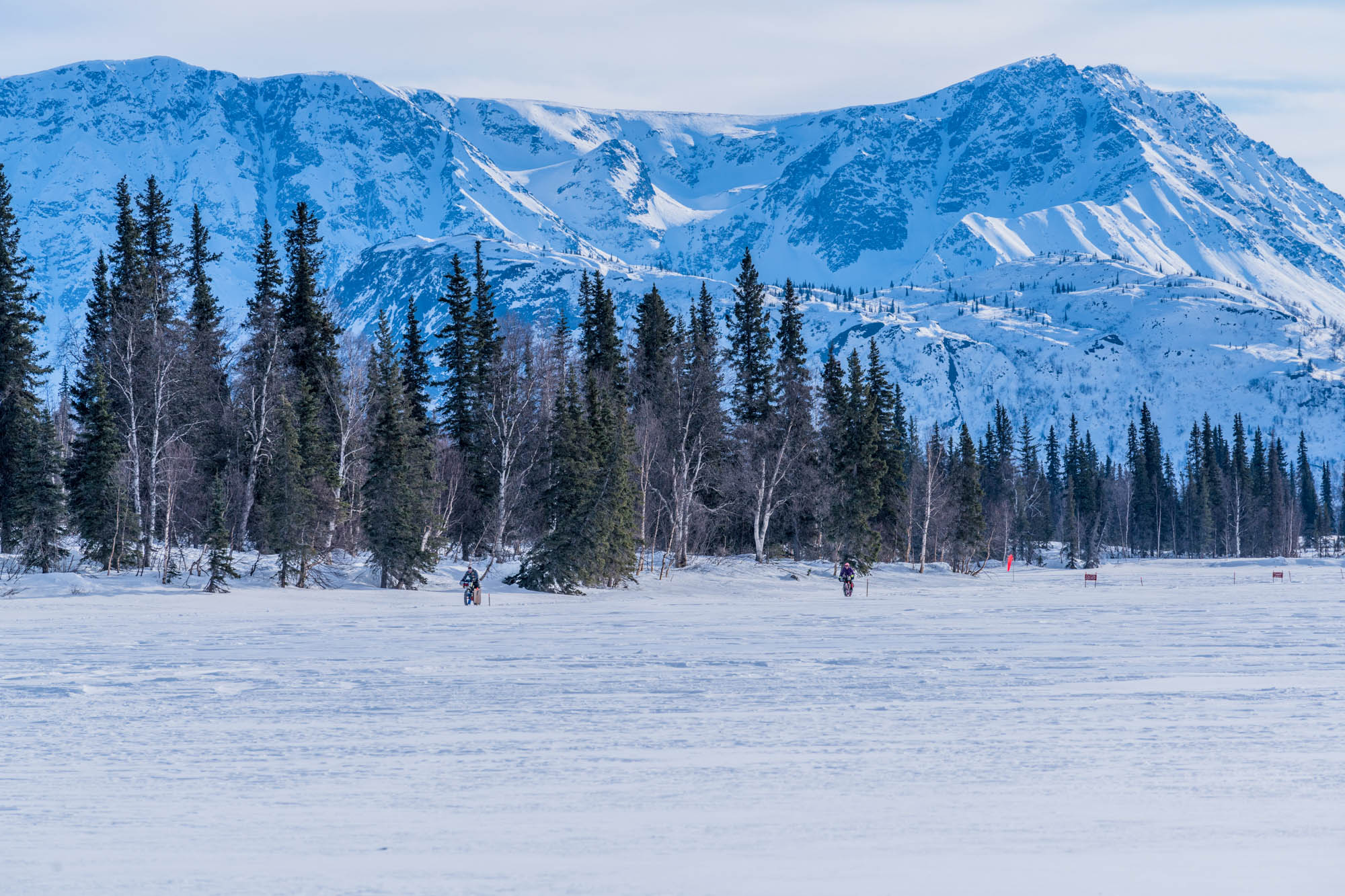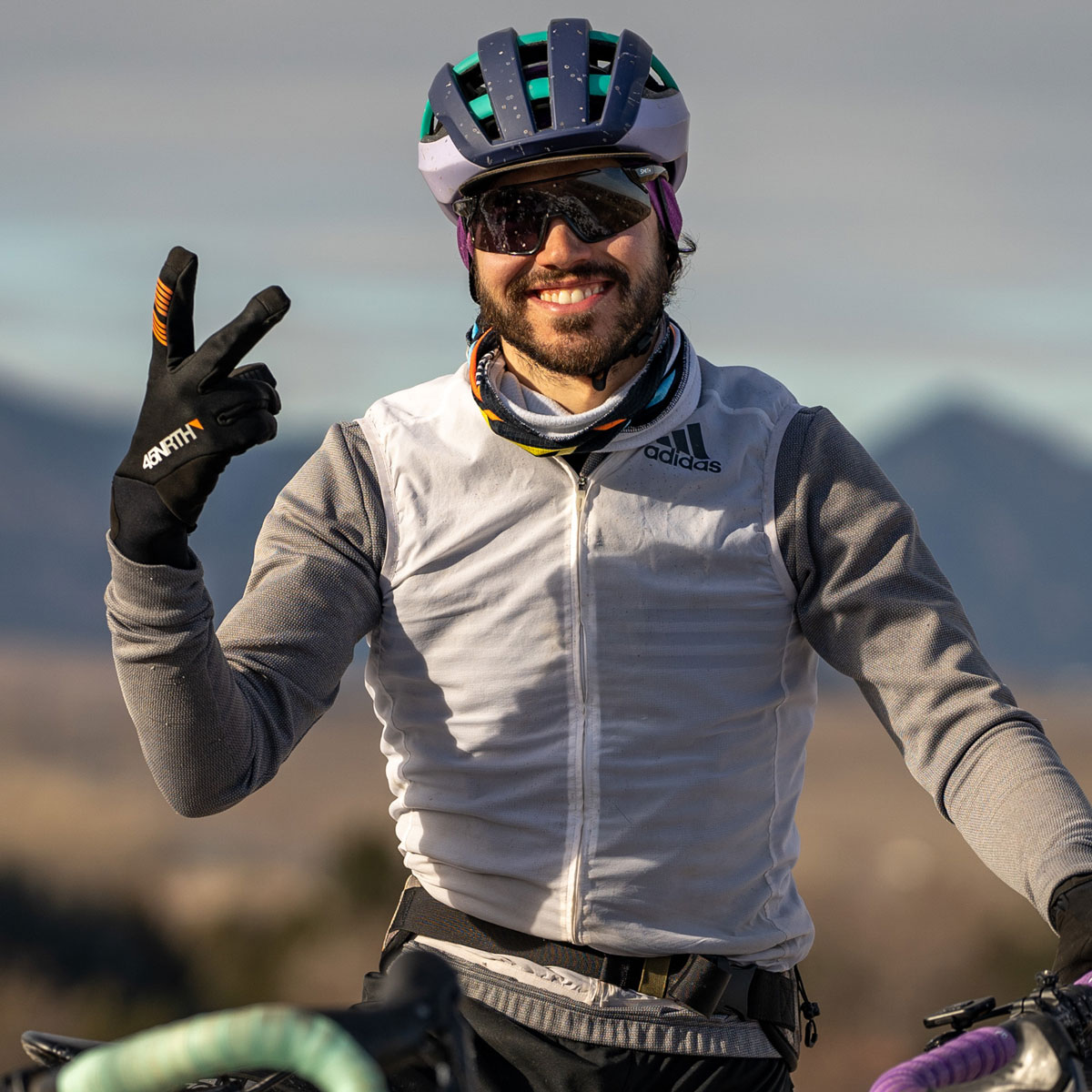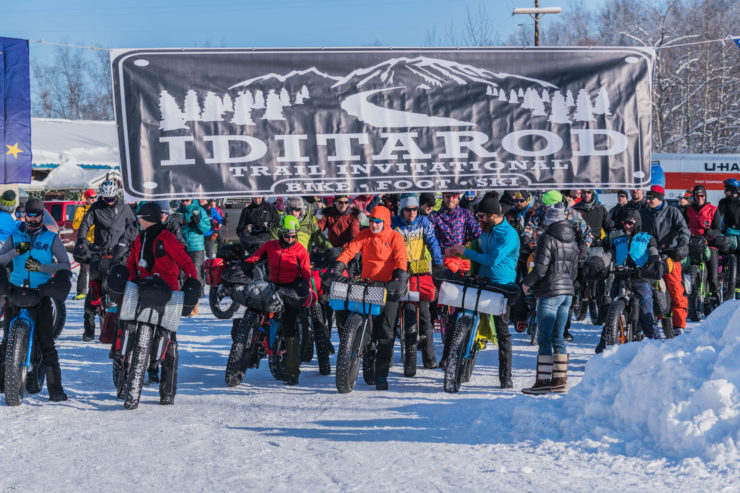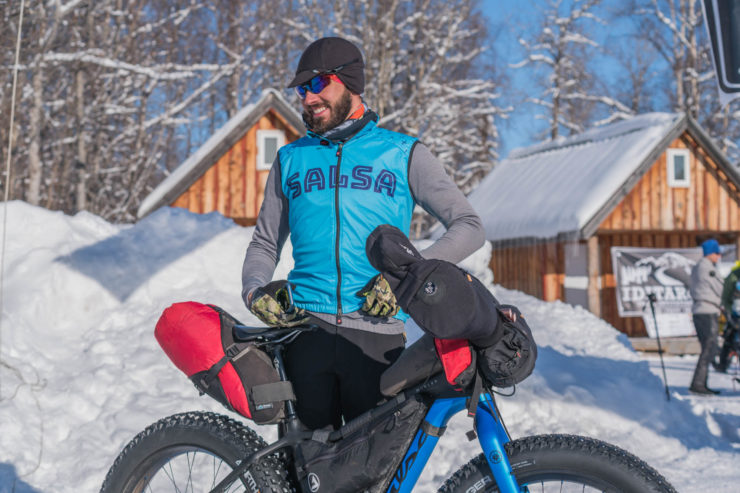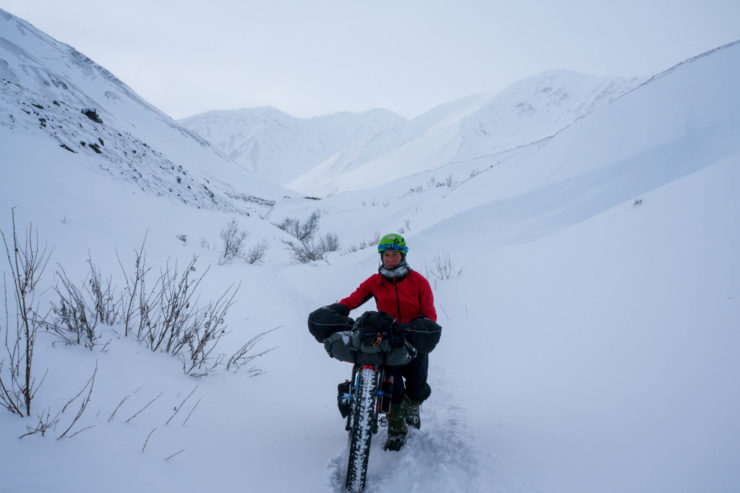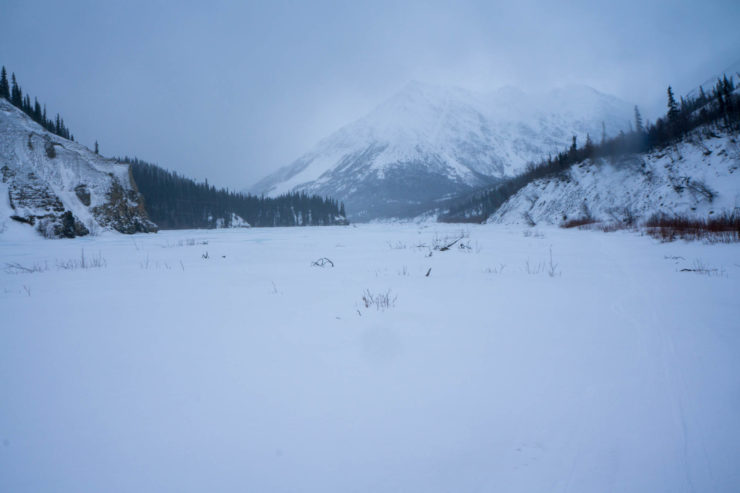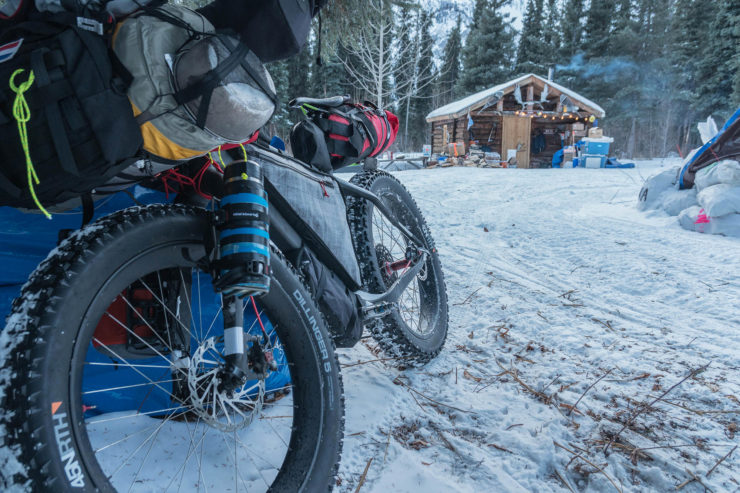Snowbound: Three Days on The Iditarod Trail
Share This
Ultra racer Neil Beltchenko brings us along for the ride in this detailed report from his victory in the 2018 Iditarod Trail Invitational 350, recounting his three-day battle against the legendary Iditarod Trail, the merciless Alaskan winter, and the competition…
As I sit on a PenAir flight, looking down at the Alaska Range and reflecting on what transpired over the last few days, my initial thought is to compare my 2018 Iditarod Trail Invitational 350 experience with my rookie run last year. It’s funny what one ride (or walk) along the route can do to your confidence, spirit, and motivation. I wrote last year about the race really starting in Rohn. That held true again this time, more or less, but I wanted to buck that trend, mix it up a bit, and I had a plan to make that happen. My goal is always to be safe, ride to the limit of my abilities, and finish. This year, I also wanted to push it hard out of the gate, have less stopped time, and sleep in smaller increments. Here’s how it all went down.
Race Day
Even before the race started, I had my eye on Clinton Hodges, a man who not only has a fantastic beard, but can also really pedal a bike. And then there was Jay Petervary, who was also racing the 1,000 miler this year. While I didn’t write him off as my main competition, I also didn’t anticipate that he’d give the push he did during the first 300 miles of the race. And as always, there are dark horses you need to watch out for, but I tried to stay focused on the goals I’d set for myself instead of worrying about the other riders. I didn’t want to be riding someone else’s race.
The shotgun startled me, and with a ring in my ear I pedaled away from Knik at 2:00 pm on Sunday, February 25th. We were off. All total, there were 45 bikers, 22 runners, and just two skiers. The pace was quick, but nothing special until we reached the pavement. From there, Jay was on a mission, leaving me confused. He pedaled hard through the first 20 miles or so until we hit a snow-covered trail for the first time.Conditions were said to be good at our pre-race meeting, but in reality, the snow was rather soft. These winter ultras are completely weather dependent. Back in 2015, John Lackey, Kevin Breitenbach, and Andrew Kulmatiski cruised on a sheet of ice from Knik to McGrath, all finishing in under 48 hours. Last year, we hiked what seemed like the entire Ptarmigan Valley, an atypical route for the Iditarod Trail Invitational (ITI), but a necessity since the other side of Rainy Pass was trashed and not rideable. The ITI typically follows the Iditarod Dog Sled Race route every year, which starts a week after us. The course may be fast or slow, but there’s no way to be sure until you’ve already arrived at the finish.

Back to mile 20, where Jay was off like a bat out of hell. Was he making a statement, or just stirring the pot? Only time would tell. We pushed past Flat Horn Lake and jumped on the Yentna River as the sun started to set. There was barely any available light, making it rather hard to see, which was a recurring struggle throughout the race.
As night settled in and my eyes gradually became glued to the reflectors along the Yentna River, I started to feel pretty good. My legs felt strong, mind clear. I was about to endure a few days in the Alaskan bush. It was a vacation of sorts. I hit a sign that said five miles to Yentna Station Roadhouse, our first checkpoint, marking 55 miles into the race. I could make out Jay’s lights in the distance up ahead, so I figured I’d give it a push to catch him so we could pedal into Yentna together.
We arrived, ate some soup, grabbed some water, and pushed on. We had a total stopped time of about 30 minutes, which was about as long as I’d taken during last year’s race. This time around, though, I at least knew what I was doing, and I felt a small sense of accomplishment in that.Rolling out, we made decent time into Skwentna. We were slightly behind our times from 2017, but not by much. Last year we had a large crew pulling us forward. This time, I was just pedaling with Jay, knowing that Clinton was never far behind. The riding was reliable, even with the bit of snow that was falling. We arrived in Skwentna just four hours after we left Yentna, right as Cindy was firing up the stove to prepare us some delicious pasta and buttery toast. When I arrive at aid stations, my goal is to shed layers, put them next to the fire to warm up, and get at least a partial reset from being outside pedaling. I always have to keep my goals front and center. This year, I wanted to be quicker, and it all started at checkpoint two. My short term goal, like many racers, is to focus only on the distance between individual checkpoints. This helps break down the race mentally, making for attainable segments of the race.
Clinton arrived roughly 20 minutes after Jay and me. Conventional wisdom says slow and steady is the trick to races like these, but all I wanted to do was get out of there as quickly as possible, and that’s exactly what I did. Jay ended up sleeping for a while and Clinton was out the door about half and hour behind me.
After a rather uneventful evening of pedaling, other than getting in to the first bit of climbing, I finally made it to the third checkpoint, Fingerlake Lodge. Once there, I decided to eat some food and take a small power nap in the checkpoint tent to rest my eyes. Once again, Clinton showed up just 20 minutes later, and I knew I couldn’t linger around for long. If he’d wanted to hustle up and get out with me, I’d have been fine with that. After all, having a riding partner is good, but there was no way I was going to wait for anyone at this point. Not having much of an appetite, I had a tiny snack and set off for the Alaska Range around 9:15 am on Monday morning, 19 hours into the race.
Clinton continued to chase me, hitting the trail roughly an hour after me. I started to climb up the Happy River Valley, a gorgeous, narrow valley that eventually opens up to reveal a stunning view into the heart of the Alaska Range. It’s here, among the mighty range separating interior and coastal Alaska, that the trail starts to become truly spectacular.
Another four and a half hours of pedaling and I made it to Rainy Pass Lodge on Pintulla Lake. From here, things were rather routine. It had been a full day since the start and I was feeling pretty good. I was obviously dealing with some of my own peaks and valleys, but nothing out of the ordinary. It was a success up to this point, but I had no idea what I would be in for over the next two days.

A Storm Was Brewing
The wind was just beginning to pick up as I pedaled into Rainy Pass Lodge. Based on my experience last year, I suspect this area may always be windy, actually. My goal for the evening was to get over Rainy Pass, hopefully making it into Rohn early in the evening so I could get a few hours of shut eye before the big 75-mile slog to Nikolai. I pushed on in somewhat soft conditions, and, after making it just a few miles up Happy River Valley, my plans of making it to Rohn that day quickly started to feel more like a dream.
As I traveled north through the valley, I found myself contending with extremely limited visibility and howling gusts of wind, both of which made it hard to remain on the packed route. It felt a bit like I was trying to ride along a balance beam, requiring my full attention to keep my front tire from sliding off and sinking into the deep snow on either side. It continued like this for the next five hours before I veered out of the Happy River Valley and up toward the infamous Rainy Pass.
I was excited to ride Rainy Pass this time around, since last year we’d taken the Ptarmigan Valley to Hells Gate. What I was not excited about was the current state of Rainy Pass. Even if the trail was in good shape an hour earlier, the storm had transported so much snow that it was nearly impossible to see anything resembling a trail. On occasion I’d catch a glimpse of a snowmobile track, following it for as long as I could before it invariably led me into waist-deep snow drifts.
There I was, in the crux of the race. It was windy, snowing, dark, and I feared that avalanches were a real possibility. Looking around, I was clearly in a terrain trap, but all I could do was continue to push. Standing still wouldn’t be smart, and turning around would be silly. It was an important race for me, but certainly not one worth risking my life for. I tried to take stock of the upsides: I was in first place, the weather was still rather warm, and I really wasn’t that tired.
Step after step, I made it to Rainy Pass Lake, then finally up to Rainy Pass, where I found various snowmobile tracks, only to lose them just ask quickly. The wind at the summit was blowing snow sideways into my face and the gusts were whipping my body and bike from side to side. I felt vulnerable, alone. It was just me and the Alaska Range – a place infamous for showing no mercy.
Moving down the other side of the pass was just as difficult. I walked down to treeline and once again found myself in a terrain trap, trying to scale the side of a hill, all the while postholing and trying to stay upright, barely able to see what was directly in front of me. I’d had enough by 11:00 pm, and I decided to call it quits for the night in a flat zone around some bushes. It was short of my goal, Rohn, but smart as a racer trying to remain alert. I set up a spot to sleep, digging a pit for some protection from the whipping wind. I blew up my sleeping pad, jumped into my -25°F bag, and set my alarm for three hours.
I struggled to sleep beyond an hour, but I closed my eyes again, trying to sneak in as much rest as I could. Waking up with just over two hours of sleep under my belt, I decided to jump out of my super warm and comfortable sleeping bag to hop on my bike again. To my surprise, the wind had finally stopped. Things were relatively calm, except for my body, and I shivered while getting my bags packed. While packing, I couldn’t help but glance over to the trail, which was clearly visible in this section. I didn’t notice any tire tracks, so I knew I still held the lead. But how much of a lead? I had no clue.After I jumped back on the bike in the early morning, I was able to pedal most of the way to Rohn. Dalzell Gorge was absolutely stunning, the moon lighting my path. The trail improved as I descended. It was clear that the Iditarod Dog Sled Race crew had put it in a lot of time to incorporate some rollercoaster-like fun into the terrain. Life was good, I was about to make it into Rohn.
20 Hours to Nikolai
I arrived in Rohn – at the confluence of the Tatina and the South Fork of the Kuskokwim – right around 4:00 am. Adrian, the amazing volunteer who was staffing the checkpoint there, cooked some brats, stoked the fire, and chatted me up for a while. I decided I’d get another hour or so of sleep in the comfort of the checkpoint tent to be as rested as possible for the push (pun intended) to Nikolai. After Rohn, things get pretty desolate though the Farewell Burn. The name itself reminds me of a bad dream, but every racer who finishes needs to travel through it, and I wanted to be alert.
I woke up an hour later, shivering and ready to move on. I packed up the food from my second and final drop bag and made a stop at the pit toilet. While in the bathroom, I heard what sounded like a tire and my heart sank. I rushed out of the small shack and saw someone outside of the tent. It was Adrian. I asked, “is Jay here?” He replied, “Not yet!” Whew. He was ruffling a tarp and it mimicked the sound of a fat bike tire churning though cold snow. My mind had tricked me. I was relieved, but wanted to get out of there ASAP, still not knowing where the rest of the pack was.
I hit the icy Kuskokwim River as I left Rohn. While pedaling, I somehow lost my line and found myself on a slanted ice shelf. Studded tires work really well on flat ground, but when you move onto a slant, where studs can’t do their job, they’re effectively useless. Before I knew it I smacked myself on the ice, my thigh crashing into the edge of a broken ice shelf, followed by my elbow. I quickly brought myself to my feet to assess the damage. The bike looked good, and the ice was intact, but I was surely going to have a nice hematoma.
I approached the ice with extra caution from that moment on, though thankfully there wasn’t much on the course this year. Still, better to be smart around the slick stuff. I pedaled atop some soft snow out of Rohn, still rideable, but averaging four or five miles per hour instead of my preferred seven or eight. I eventually reached Farewell Lakes, just as the sun was rising. I heard someone yelling at me. Was I hallucinating? I didn’t anticipate seeing anyone, but certainly wouldn’t turn down a conversation. I looked to my right and sure enough, there was a man asking me if I wanted some coffee or water. I declined, but he asked again. I told him I was all set. He obliged, but told me to expect to lose the trail a few miles ahead. So much for the good trail everyone was talking about at the racers’ meeting. The wind we had dealt with up on Rainy Pass must have done a number to the trail, I assumed. I thanked him for the information and kept moving.

Settling into the Slog
Maybe three miles later, I found myself pushing my bike through heaping snow drifts across a frozen swamp. Step after step, I found myself sinking into the snow, anywhere from a few inches to waist deep. At times, I resorted to completely dragging my bike, as rolling it over the snow just wasn’t an option. Things had changed, drastically.
I had a realization as I followed the trail through the burn area: I was racing, sure, but the real reason I sign up for these endeavors is to experience the natural beauty, and – especially in the case of the Iditarod – the history. I felt what so many previous finishers before me have felt. A spirit, so to speak, something that can only be described or understood on the Iditarod Trail. From the Alaska Natives all the way to us crazy fat bikers and runners, as we traveled along the route, each one of us continued to cement a new slice of history. Someday, I hope someone else will have a moment to reflect there as I was then.
Back in the snow, it was just me and the trail, and I had to get to Nikolai somehow. Still uncertain where Clinton, Jay, and the rest of the riders were, I continued to push through the deep snow. I’d occasionally find a good pocket to ride, or get into an area with some tree cover, but I’d always eventually end up back on an open, frozen swap, or in another burn area, where there was no little to no protection for the trail. I did everything in my power to move swiftly, testing the side of the trail, the middle of the trail, even trying to walk on the bushes and shrubs. My mental peaks and valleys continued to come and go, but this valley lasted a while, basically until Nikolai. The icing on the cake in this struggle was the lack of visibility. The combination of wind, blowing snow, and low light meant I’d often find myself pedaling straight into a drift, and sometimes in the wrong direction entirely.
As I finally approached Bear Creek Cabin, a midway point and safe haven on the route, I was greeted with slight reprieve. I had no intent of sleeping there as it was far too early and my next goal was Nikolai. Passing the turnoff for the cabin, I noticed the trail starting to improve, at least slightly. The trail was somewhat packed down by snow machines, likely driven by folks who’d been staying there the previous night. While it helped, it was far from an ideal situation. The trail was still rough and the wind was whipping around, but there was a bright side – now I could pedal yards at a time instead of feet!
While breaking trail throughout the day, I’d wondered if maybe I was helping out the guys behind me, but when I turned around and looked, I was confident my tracks would be covered even if they were only an hour behind me. The wind was blowing so hard and transporting immense amounts of snow. In fact, I think it was only getting worse. Only time would tell.As night fell, I made a pretty good dent in my 70 miles to Nikolai. I had 20 miles to go and still felt alert. I knew I had 20 miles because the reflective signs on this stretch kindly share how far you are away from the next town. While this is maybe a nice feature for some, specifically someone making great time, for me, it just showed how slow I was going. It took me 13 hours to travel 55 miles. It was hard not to think about a faster pace, but in the end, I told myself that if this is the case for the rest of the race, I would have to deal with it. There was nothing I could do but just push forward.
I was running out of food and water, but I knew Sullivan Creek was coming up ahead I’d need to grab some water to make it to Nikolai as swiftly as I could. As I arrived at the creek, , the wind was still whipping, the storm clouds had cleared, and the temperatures were dropping fast. As many racers do to keep their hydration system from freezing, I had to shed most of my shirts, jerseys, and jackets to access and refill my Camelbak. It was freezing, but I made quick time in filling it up and was on my bike, pedaling through a thick forest along protected trails for the first time in a while. I hit the 90-degree trail junction turn, which signifies 10 miles left to Nikolai. I was excited for a change of direction, excited for a turn, and excited that I only had 10 miles to go. But, as I exited the trees and entered the frozen swamps again, conditions quickly deteriorated.
It was slow going, somehow even slower than the previous 10 miles. The way the wind hit the trail made me have to constantly rethink where the best place to ride was. Was it on the left? The right? Center? I couldn’t figure it out. Was I too fatigued to think straight, or was it just a crap trail? I decided on the latter and pushed forward. Your mind can mess with you out there, especially when you have to think all day long. I could feel myself dozing off as night inched closer, and I struggled to find focus. I was having a fight with myself about whether I should bivy out or push on to Nikolai. I decided to eat some caffeine, as I often do when I get to this point. If it works, great. If not, then it’s time for bed. It wasn’t working.It was colder than snot, and there was no way in hell I as going to bivy out. I was prepared to bivy, but I just couldn’t bring myself to do it. So, I did what I had to do: I pushed, and pushed, and pushed. My eyes and mind exhausted, legs and heart determined. I pictured this 10-mile ride I do all the time back home, thinking about how long it would take me to walk that stretch. It eased my mind. Eventually, I reached a corner, where I was greeted with lights, real lights, like ones you would see in a town or city. It was Nikolai, and boy did it feel good. I looked over my shoulder once more to see if I could see anyone on my tail. Nothing. I was alone, and all 90 or so people in the town were still sleeping as I found my way to the community center, the last checkpoint of the race.
One Last Push
I parked my bike outside of the checkpoint, tossed my trash, assessed my remaining food, and went inside. I was greeted by Jenny, the checkpoint volunteer. She told me I was doing great. In my mind that meant way to make it here, but those guys are on your ass. She had the race tracker pulled up on her computer, and she pushed it in my direction. Looking at the screen, I was instantly relieved. To my amazement, I had a comfortable lead. I did some math in my head and guessed I was maybe five or so hours ahead of the others. I decided to take it easy, sleep a few hours, and make the final push to McGrath after getting some solid rest.
I set my alarm for 3:30 am, but I slept right through it. I woke up at 4:30 am, confused, disoriented, and panicked. I quickly packed my things, scrounged up some food since I was basically out, and boogied out of there around 5:00 am. Looking back at the tracker after the race, it turns out I still had 30 miles on them, but I didn’t know that when I left. In retrospect, I’m grateful for that, because I pedaled like they were right behind me.Back on route, I was kindly greeted with a substandard trail yet again. This recurring theme was slowly chipping away at my soul. And, to make things worse, there were tracks from hikers using the trail. There’s another race, the Iditasport, that takes off about a week before ours, and I’d caught them, or at least their tracks. It felt like I was going over cobblestones on a road bike with skinny tires inflated to 120 psi. It hurt, and it lasted the entire way to McGrath. The upside? I could actually stay on my bike. I had that going for me, I guess.I knew I had a total of 50 or so miles from Nikolai to McGrath. It was a good feeling, but there was still plenty of work to be done. My body felt great, but my head felt cloudy. The cold temperatures and lack of sleep made me want to bivy out, but this is a typical hurdle I encounter this late in the game. I started doing math in my head, which is something I end up doing a lot of. If I kept an average of four miles an hour, I’d be in McGrath in roughly 12.5 hours. So, that was the number I kept. If I was faster, great. If I was slower, well, there is was nothing to be done about that.
As the sun rose and my body began to thaw out, I eventually I made it to the Overland/River Junction. Last year, I was under the impression that I had to follow the track in its entirety. I later found out that as long as you go through each checkpoint, you can take any route you want. Mind you, there aren’t that many routes up there, but there is one particular option that undoubtedly saves time and mileage if the trail is broken in. Instead of turning right on the river trail like I did last year, I hung a left on the Overland Trail. Between the two trails, this trail looked more packed down, and I felt more efficient from the moment I turned onto it. My speed increased and I felt confident that I’d be able to maintain my new pace. Lucky for me, I did, though not without struggling through a few windswept areas along the way.

One pedal stroke after the next, I became more and more excited. I also noticed myself worrying a lot more about avoiding unwanted mechanical issues. I continually checked my tire pressure so as not to get too low and burp a tire, and my shifting also became more crisp. I did everything in my power to play it smart during my last few hours on the course.
Finally, I made it to the unplowed but still rideable Vanderpool Road, a spillway road east of McGrath. The road shoots over hills, many of which you can see in the distance, making it frustrating, but I eventually made it through, funneling onto the plowed section of road. From there, I peeked over my shoulder one final time and knew I was about to accomplish something I’d been dreaming of for years, an Iditarod Trail Invitational 350 win.
The last mile or so on route led to a lot of reflection, strong feelings of triumph, and plenty of emotion. I shed a few tears as I pedaled past a small but loud group of supporters, fully aware that this moment wasn’t just the result of hard work during the race, or during training. This was two years in the making. I rolled into Peter and Tracy’s house at 3:04 pm on Wednesday, February 28th. I didn’t have to ride my bike or look over my shoulder anymore. I had won the ITI 350, and boy, is that a great thing to be able to say. I finished with a total time of 3 days, 1 hour, and 4 minutes.
Epilogue
I want to thank Kathi, Kyle, and all of the volunteers for putting on such a fantastic race. I understand this is an undertaking, especially this year with poor weather making it logistically challenging for volunteers to get where they need, but you guys did a great job. I also need to thank my wife, family, and friends. I know it’s not easy to watch a dot and figure out how I am doing, but I thank you for your sacrifice while watching me. It means the world to me that I’m that important to you.
Lastly, this could not be possible without my partners. Over the past two years I have done some pretty incredible things on bikes in big part because of their support. Thank you Adidas Terrex for the warmest, most functional clothes I could ask for, Salsa Cycles for the best fat bike machine out there, 45NRTH for keeping my biscuit warm, and for the Dillinger 5s, the best tire for Alaska, Industry 9 for always providing reliable and fast rolling hubs, and Tailwind Nutrition for that jolt when I needed it, and I needed it a lot this year.
Stats According to trackleaders.com:
Average: 4.1 MPH
Moving Average: 4.6 MPH
Route Distance Per Day: 98 Miles
Moving Time: 2 Days: 13 Hours: 13 Minutes
Stopped Time: 12 Hours: 12 Minutes
FILED IN (CATEGORIES & TAGS)
Inspiration
Your Stories
bikepacking-ultra-racing fat-bike-bikepacking winter-bikepackingPlease keep the conversation civil, constructive, and inclusive, or your comment will be removed.






